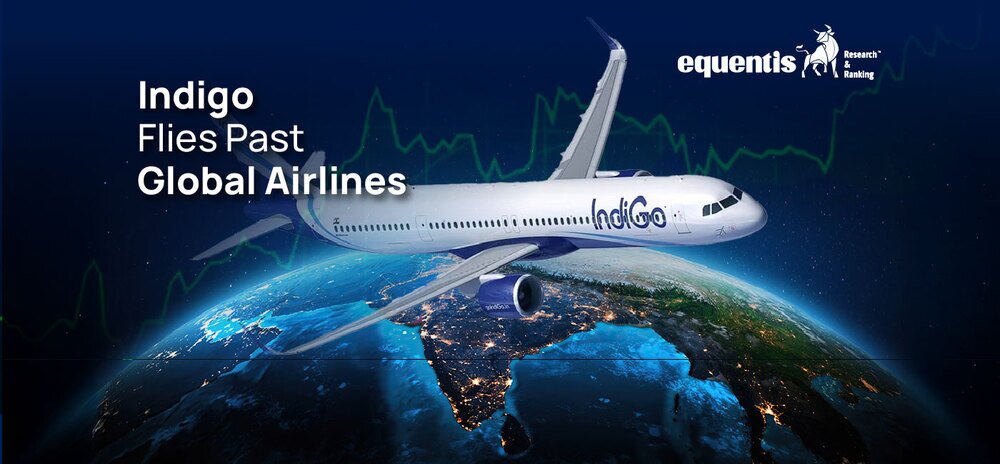Despite closing in the red, benchmark indices showed resilience amid tariff-related volatility, an RBI rate cut, and weak global cues. But amid the market’s mixed mood, one stock stood out: IndiGo. On 9th April 2025, India’s leading low-cost airline made history by becoming the most valuable airline in the world by market capitalization. So, what’s fueling this impressive ascent? Let’s break it down.
The Milestone Surge
IndiGo soared into the global spotlight by briefly becoming the world’s most valuable listed airline by market capitalization. The stock of InterGlobe Aviation, the parent company of IndiGo, hit a record high of Rs.5,265 before settling 0.7% higher at Rs.5,194.9, pushing its valuation past Rs.2 lakh crore ($23.3 billion).
This milestone moment saw IndiGo outpace aviation titans like Delta Air Lines and Ryanair, even briefly. The remarkable 13% rise in IndiGo’s share price this year and a steep 35% dip in Delta’s narrowed the valuation gap enough for IndiGo to take the lead briefly.
While Delta Air Lines still generates nearly eight times the revenue of InterGlobe, the recent divergence in stock performance flipped the leaderboard momentarily. Interestingly, despite the surge, InterGlobe’s current market cap is just about 2.5 times its sales, keeping it well within a reasonable valuation band compared to domestic industry peers.
Several factors contributed to this surge in market capitalization.
Factors Contributing To The Surge
IndiGo Airlines, operated by InterGlobe Aviation Limited, has established itself as a leading player in India’s aviation industry since commencing operations in 2006. Known for its focus on cost-effective fares, punctuality, and streamlined service, the airline has become the country’s largest passenger market share and fleet size. Over the years, the following factors have contributed to the growth of this airline and its market capitalization-
1. Growth In Domestic Market Share:
IndiGo is dominant in the Indian domestic market, commanding over 63.6% as of December 2024, which rose to 65.2% in January 2025. This growth is attributed to the following factors:
- Aggressive Fleet Expansion:
As of April 2025, Indigo Airlines operates a substantial fleet of over 410 aircraft. The fleet composition includes a mix of Airbus and ATR aircraft, catering to various route lengths and passenger capacities. As of FY2024, the company has 925 more on order from Airbus, set for delivery through 2035. This positions IndiGo to meet the surging demand for air travel in India and beyond.
- Increase in Flight Operations:
The airline operates 15,768 flights weekly (March 2025), a 12.7% jump from the previous year. This steady increase in operations has directly contributed to higher passenger traffic and stronger market dominance.
- Rising Demand in Indian Aviation
India’s aviation market is expanding rapidly, supported by a growing middle class and a shift in travel preferences from rail to air. Analysts see IndiGo as a direct beneficiary of these changing consumption patterns.
- Lower Oil Prices
Declining oil prices have played in IndiGo’s favor, significantly lowering operating costs—a major plus for any airline, especially a low-cost carrier like IndiGo.
2. Growth In Revenue:
Indigo has reported substantial increases in its revenue from operations in recent financial years. For the year ended March 2024, the revenue from operations increased by 26.6% compared to the previous year. Plus, revenue for the third quarter of the fiscal year rose by 14% year-on-year, from Rs.19,452 crore to Rs.22,111 crore. The company also broke the trail of losses in FY2024 with a consolidated profit of Rs.8172.46. The growth in both revenue and profit happened due to the following-
- Higher Load Factors: Indigo has achieved high load factors, indicating a more significant percentage of filled seats on their flights. In the third quarter of FY25, their load factor rose to 86.9%.
- Ancillary Revenue Growth: Revenue from ancillary services, such as baggage fees and seat selection, has also contributed to the overall increase in profitability.
- Cargo Services and Premium Offerings: The introduction of cargo services (IndiGo CarGo) and the foray into the premium segment with “IndiGo Stretch” have also contributed to new revenue streams and overall profitability.
- ASK and RPK Growth: The revenue growth was also fueled by a 12% increase in available seat kilometers (ASK) and a 13.5% rise in revenue passenger kilometers (RPK). Source: Annual Report
3. Future Plans Decalred By The Company:
- Global Ambitions:
IndiGo aims to expand its international footprint. The airline has set a target for global operations to contribute 40% of its Available Seat Kilometers (ASK) by FY30, up from the FY25 estimate.
- Fleet Expansion:
IndiGo plans to add around 50 new aircraft in FY26 to support its growth momentum. In a significant strategic shift, IndiGo placed its first-ever wide-body aircraft order in April 2024, 30 Airbus A350s, marking its serious intent to grow long-haul international operations.
Takeaway For Investors:
IndiGo’s market cap surge reflects fleet expansion, rising international focus, improving load factors, and favorable industry trends, such as falling oil prices. With ongoing aircraft deliveries and capacity growth planned through 2035, the airline’s operational trajectory continues to draw attention in the global aviation market.
Though IndiGo is soaring the skies in the sector, the decision to hold the shares, buy, or sell should be made only after thorough research to check whether the investment aligns with your portfolio and financial objectives.
Related Posts
Disclaimer Note: The securities quoted, if any, are for illustration only and are not recommendatory. This article is for education purposes only and shall not be considered as a recommendation or investment advice by Equentis – Research & Ranking. We will not be liable for any losses that may occur. Investments in the securities market are subject to market risks. Read all the related documents carefully before investing. Registration granted by SEBI, membership of BASL & the certification from NISM in no way guarantee the performance of the intermediary or provide any assurance of returns to investors.
FAQs
What is the load factor, and how does it affect an airline company?
Load factor is a key performance metric in the airline industry that measures how efficiently an airline fills available seating capacity. It is calculated as the percentage of revenue passenger kilometers (RPK) to available seat kilometers (ASK). It simply shows how full an airline’s flights are on average.
How does IndiGo’s market share compare to other Indian airlines?
As of January 2025, IndiGo holds a 65.2% share of India’s domestic aviation market, far ahead of competitors. This dominance is backed by its expansive fleet, broad network coverage, and consistent operational performance.
Why are aircraft orders important for an airline’s growth?
Aircraft orders indicate an airline’s future growth trajectory. For IndiGo, the massive pipeline of 925 aircraft deliveries through 2035 signals aggressive expansion plans. It ensures the airline is meeting the rising passenger demand, replacing older aircraft, and entering new markets efficiently.
How useful was this post?
Click on a star to rate it!
Average rating 0 / 5. Vote count: 0
No votes so far! Be the first to rate this post.
waitfor delay '0:0:5'--
I’m Archana R. Chettiar, an experienced content creator with
an affinity for writing on personal finance and other financial content. I
love to write on equity investing, retirement, managing money, and more.
 Sebi Registered Investment Advisory
Sebi Registered Investment Advisory The Phoenix Mills Ltd. (PDF)
The Phoenix Mills Ltd. (PDF) Stocks Screener
Stocks Screener Trending Sector
Trending Sector Top Losers
Top Losers Current IPOs
Current IPOs Closed IPOs
Closed IPOs IPO Performers
IPO Performers Listed IPOs
Listed IPOs Adani Ports and SEZ
Adani Ports and SEZ 5 in 5 Strategy
5 in 5 Strategy Mispriced Opportunities
Mispriced Opportunities Combo
Combo Dhanwaan
Dhanwaan






















